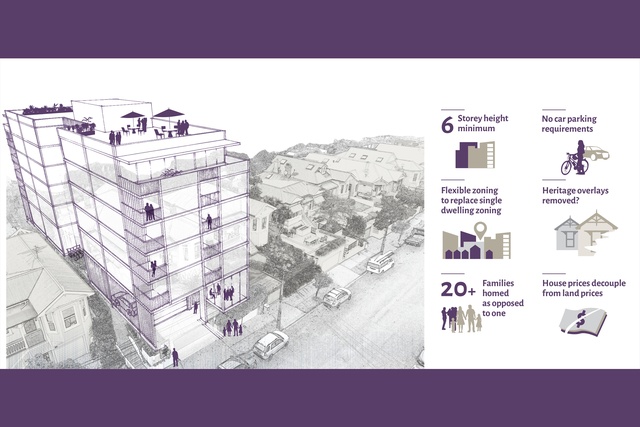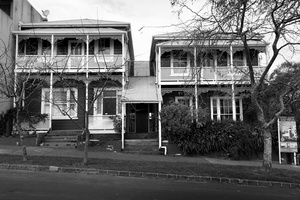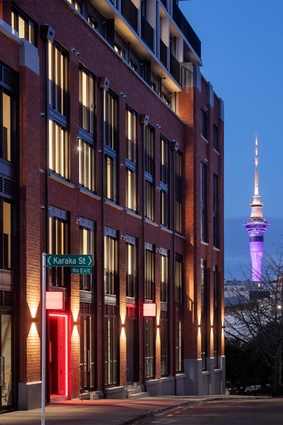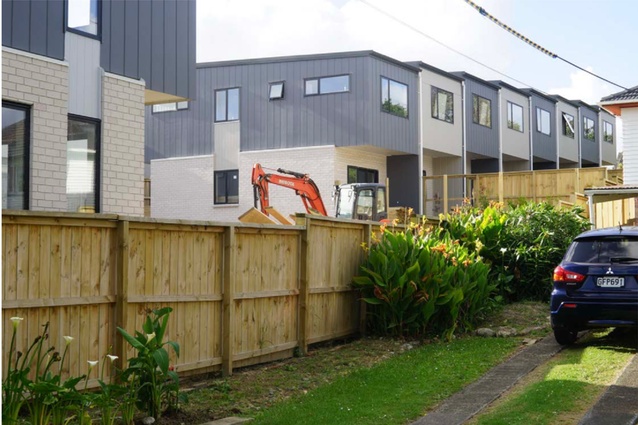A win – and, potentially, a loss – for future generations
In the long-standing battle between vested ratepayer interests and future generations, future generations have scored a goal with the National Policy Statement on Urban Development (NPS-UD), winning access to our future CBD and amenity-rich city fringe suburbs. Yet, they may have lost out with the Enabling Housing Supply Amendment Act and future living in the (post-mortem?) leafy suburbs. Lisa Hinton from UDINZ looks at the hits and misses of the new intensification legislation affecting Auckland City.
What’s it all about?
The 2015 Productivity Commission found that our cities’ planning systems are overly restrictive, inhibit development and are (in large part) responsible for rising house prices. Planning systems and rules and how councils consent to developments determine how cities respond to housing demand.
The apartment blocks built in Auckland up until the ’70s were subsequently banned, and our restrictive planning system created today’s low-height, car-oriented inner cities. The Unitary Plan only partially opened up Auckland city. Restrictive rules around single dwelling zoning, car parking and things like heritage overlays effectively stifled development in the areas young people most want to live.
The National Policy Statement on Urban Development (NPS-UD), enacted in August 2020, aims to unlock land supply by introducing more flexible zoning, increasing density to six-storeys in inner-city suburbs close to transport, and removing minimum car parking requirements (MPRs). The Enabling Housing Supply Amendment Act, passed into law in December 2021, furthers this density mandate, extending it across all Auckland suburbs and allowing development to be three storeys, with no minimum dwelling size and no minimum lot size.
The Government had two objectives for the housing supply bill – the first being to allow the market to generate a supply of an extra 108,000 dwellings over 10 years and the second, to engineer a permanent structural change allowing our cities to densify.
The upshot of both Government directives is to force local councils to make way for apartments of six storeys or more in and around Auckland’s CBD and its 10 large urban centres, as well as increasing medium-density housing (up to three storeys) across most Auckland suburbs.
Council’s public consultation is a catch-22
Councils are often held hostage to ratepayers’ demands, as it is the ratepayers that pay their wages.
And, very often, ratepayers want to keep everything just as it is, limiting development that might change the character of their inner-city suburb or their street, known as NIMBYism. The 2015 productivity report showed ratepayers and homeowners were incentivised to oppose growth and had “a disproportionate influence in local council processes.”
The mechanism of councils seeking public feedback on their city or district plans is often self-defeating. The people with the most clout, and the loudest voices, are usually those with vested interests in keeping everything as is. This was the ‘catch-22’ of the Auckland Unitary Plan’s extensive consultation process.

Ultimately, this left Auckland ground down with restrictive blanket overlays, unable to expand and contract with population growth or demand. As my 18-year-old son observed driving down Ponsonby Road, “it’s strange that this is a young, hip suburb but only old people can afford to live here.”
This is the crux of the issue and why the Government’s NPS-UD is so important and transformational for Auckland. Its genius lies in the fact that the Government did not have to ask ratepayers how they felt about densification – they already know how ratepayers feel about densification.
Rather, they have put future generations first, codifying densification into law, and making it a legal requirement for councils to change their planning playbooks, forcing the issue of building up.
Auckland Council has, and is, going out for consultation on how the NPS will change the Auckland Unitary Plan – the city’s main planning rulebook – but has a warning for ratepayers. They cannot change the trajectory, saying that “consultation isn’t a Government requirement”.
Read: Nothing you can say or do will change this. We are building up. Possibly in your suburb. Whether you like it or not.
In June last year, UDINZ hosted a panel discussion ‘Rezoning Ponsonby’ in Ponsonby, Auckland. Most of those attending had not heard of the NPS-UD, and did not know about what it meant for traditionally single-dwelling-zoned, villa-laden suburbs like Ponsonby. So, this may yet be a surprise for many.

Where to now for Auckland with the NPS?
A hiatus between central Government legislative enactment and local council city plan implementation is leading to confusion in some development circles.
What can I develop and where? Will this six-storey, mixed-use development within 800m of a transit route in a city fringe suburb, currently zoned for single dwellings, be given consent?
How does the council handle the in-between phase?
We are in the murky grey zone between the NPS having come into law at central government level and the intent being codified into local council planning rules.
But this will soon change. Auckland Council has until 20 August 2022 to integrate the NPS-UD into the Auckland Unitary Plan and to notify changes to the public.
Specifically, from the NPS-UD enactment date in August 2021, councils have 18 months to remove the minimum car parking requirements and two years (until August 2023), to enable intensification and institute flexible planning rules.
Swords out over heritage and special character areas
The NPS-UD is set to have a profound and transformational impact on the single-dwelling zoned inner suburbs of Auckland.
Blanket protections have been replaced by ‘qualifying matters’ enabling site-specific tolerances when councils determine consent.
Under the Unitary Plan, blanket overlays and single-dwelling zoning protected whole suburbs and swathes of streets from development, however, under the NPS-UD, the opposite applies. Future generations are being protected from anti-development advocates, turning the tables in their favour.
Ratepayers and homeowners who don’t want development will have to fight it out – likely in court – and will have to produce data-based evidence to back up their argument.
“The evidential threshold for limiting building height and density is very high and will be tested through public submissions, hearings, and independent expert review,” states Auckland Council. This ultimately means slugging it out as to whether a site should be protected or otherwise, with the odds stacked against the ‘retain’ position.
“While the Government allows for some exemptions to limit building heights and density, these are on a site-by-site basis. We can’t use them without providing strong evidence to prove why further housing density should be limited,” says Council.

And then there will be the question of what is quality? Auckland Council has said that within walkable catchments in Auckland – that is walkable areas 1200m or 15 minutes walk from the CBD, or 10 minutes walk or 800m from a rapid transit link – only areas with ‘high quality’ special character value have been identified to be protected.
What is ‘high quality’ and what does lower quality special character value look like? These value calls will no doubt be the source of debate.
“There are some existing areas that have not retained their special character value. It is proposed that these areas will change to support more housing density.”
Again, what makes one area more special than another, and what gives it more character values than another?
And Auckland Council gives ratepayers a final word of warning: “Not complying with Government’s requirements could result in losing more of Auckland’s special character areas.” – Resistance is futile.
Keeping the volcanic cones and sightlines
Importantly, sightlines to and around Auckland’s distinctive landscape of volcanic cones must be protected in the Unitary Plan.
The many maunga in the Tāmaki isthmus are symbolic of the city, its connection to land and mana whenua. The sightlines to these volcanic cones act as visual connectors fusing Auckland into a symbiotic whole.
It is unlikely that six-storey development will impede these sightlines, but should be explicitly stated and codified into the Unitary Plan, as the cones and the connection to them, are of value and amenity to everyone who lives in Tāmaki Makaurau, Auckland.

The Enabling Housing Supply Amendment Act – a good or bad addition?
The Enabling Housing Supply legislation needs a closer look. How will we keep the connection to the land and a sense of place if we enable the maximisation of all sites? We don’t want to end up with large impermeable areas, too small a unit type, too much concrete, too close a neighbour, and not enough outdoor space to live and breathe.
The addition of the Enabling Housing Supply Amendment Act in December 2021 was unexpected, and there was some confusion about how this would work in with, or complement, the NPS-UD, enacted some 15 months beforehand.
The Government says the Housing Supply bill will “cut red tape” and allow up to three homes of up to three storeys built on most sites without the need for resource consent. Homes can be built within 1m of a neighbouring side and rear boundary.
“…the focus is really about bulk and location, not architecture and design.” - John Duguid.
The Enabling amendment legislation feels quite different in flavour to the NPS-UD. It is about enabling townhouses, terrace houses and low-rise apartments in the suburbs, expanding the remit of densification from areas of high amenity to our low-lying suburbs.
As John Duguid, Council’s general manager of plans and places said at the time of its enactment, “the focus is really about bulk and location, not architecture and design.”
With this new legislation, it seems that design rules and considerations around height to boundary ratios, etc., were being thrown out the window, giving anyone with a plot of subdividable land – not just developers, but your Mum and Dad investor types – the ability to maximise or push to the limit sections for yield with townhouses or terraced houses without consideration of what makes a place good to live in.
The Act feels like it detracts from the good of the NPS-UD, which is very much targeted at inner-city, amenity-rich, well-designed larger density and mixed-use developments, not your four-by-two small suburban section development.
Developers of larger apartment complexes near the city are buying high-value land and are in a fiercely competitive market to attract the discerning inner-city urbanite, which by default leads to good design outcomes, and amenity-rich density done well.
With the NPS-UD we’re looking at this:

Whereas with the Enabling Housing Supply Act we’re looking at this:

One works to densify in the places young people (in particular) want to live, while the other has the potential to be a destructive force in the suburbs, creating tensions between neighbours, especially in suburban areas.
Commercial realities will kick in
On the plus side, with current land prices and construction costs, where it costs approximately 30% more to build now than a year ago, and where our housing prices jumped some 46% from 2019, it means the economic viability or business case for a small subdivision and infill development is not there at the moment.
The current commercial reality is a dead weight around the Enabling Housing Supply bill’s ability to do its work. (Of course, as the supply chain eases up, this will change too).
“With 20,000 consented houses currently being built in Auckland, we could be looking at an oversupply issue, rather than our decade-long undersupply issue.”
Of the approximate 20,000 building consents issued in the last year in Auckland – up from around 4000 10 years ago – 70% of them are for attached dwellings, or apartments and terrace housing. So, it is clear we are already moving strongly in the direction of increasing density, with or without the Enabling Housing Supply bill being in force.
There is also an argument that with net migration running at a loss, and with more people leaving than arriving, the demand has gone down in Auckland. With 20,000 consented houses currently being built, we could be looking at an oversupply issue, rather than our decade-long undersupply issue. And, given the housing enabling legislation was about adding another 108,000 houses in 10 years, when we are already building 20,000 of them, some of which may not find buyers, it begs the question of why it was enacted in the first place.
Bringing it all together
Currently, the two pieces of Government directives don’t appear to work symbiotically and have very different flavours and potential outcomes.
It is UDINZ’s view that the two pieces of legislation need to be codified in planning playbooks to work together cohesively so that design principles that apply to any development – be they six-storey mixed-use in the inner city, or three townhouses in the suburbs, are consistent.
It does mean keeping good urban design principles in the playbooks, which is not currently part of the Enabling Housing Supply bill.
“In our biggest city, many people are forced to live in locations that are far from their places of work, locked into long commutes without public transport options.” - Dame Fran Wilde.
The NPS-UD will likely have the biggest impact on Auckland city for 50 years. With house prices outstripping income levels, and young people effectively being shut out from living close to the city, this flexible zoning could have a profound effect over time on younger generations being able to live in, or near, the city. And that is a very good thing.
As UDINZ Chair Dame Fran Wilde says, “In our biggest city, many people are forced to live in locations that are far from their places of work, locked into long commutes without public transport options.” The NPS-UD will no doubt help even out the playing field, and make our cities more equitable ad accessible.
The Enabling Housing Supply bill, on the other hand, doesn’t have nearly the same merit and could be, or should be, amended.

The Urban Development Institute of New Zealand (UDINZ) is a newly formed organisation, chaired by Dame Fran Wilde, to encourage collaboration and unity within the sector. Learn more at udinz.nz.
For more on the Enabling Housing Supply Act, see this article written by 2021 NZIA Gold Medal recipient Julie Stout.












